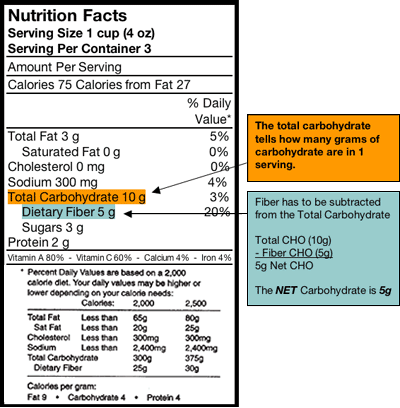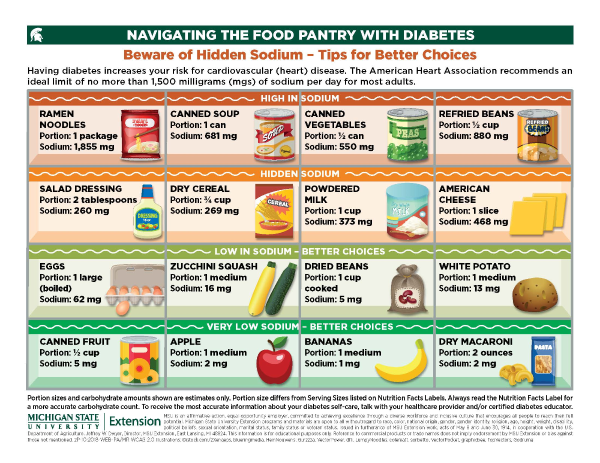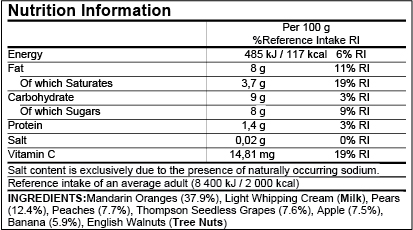40 carbohydrates on nutrition labels
Nutrition Facts Label: Carbohydrates | Conagra Nutrition Carbohydrates come in three main forms: starch, sugar, and fiber. When foods contain carbohydrates, they're often a mix of these forms. In packaged foods, the grams and types of carbohydrates are listed on the Nutrition Facts Label. Food Labels and Counting Carbs - dummies Total Carbohydrate is listed in grams. Because %Daily Value is written in bold and off to the right side of the label, and lined up neatly with the actual amount, it is easy to allow your eye to zero in on the %Daily Value rather than the actual amount in grams.
Carb Counting #2: Nutrition Labels Total Carbohydrate reflects all sugars, including sugar, starch, fiber, and sugar alcohol. The "Sugar" listed under Total Carbohydrate is very misleading; all carbohydrate (sugar and starch) is included as part of "Total Carbohydrate." Be careful, it's easy to confuse the weight in grams of the food item with grams of Total Carbohydrate.
/Untitled-design-1--5755c3703df78c9b46903dab.jpg)
Carbohydrates on nutrition labels
PDF What It Is - Food and Drug Administration The Nutrition Facts label also lists the types of carbohydrate that make up the total carbohydrate in a product. This includes the amount in grams (g) per serving of dietary fiber, total sugars,... What Is the Difference Between Sugar & Carbs on Food Labels? Each gram of carbohydrate and protein provides 4 calories, while a gram of fat provides 9 calories. Carbohydrates are found in a wide variety of foods, such as grain products, including bread, pasta, breakfast cereals, oatmeal, flours, crackers, starchy vegetables like potatoes and corn, legumes, milk, yogurt, fruits, juices, sugar and desserts. Food Labels: Carbohydrates | Home & Garden Information Center According to nutrition experts, carbohydrates should provide 45-65% of your total daily calories. That means carbohydrates should supply 900 calories or more in a 2,000-calorie-a-day diet. Facts on Food Labels Food labels contain clues to a food's carbohydrate content, including the amount per serving.
Carbohydrates on nutrition labels. Understanding Food Nutrition Labels | American Heart ... Remember that the information shown in the label is based on a diet of 2,000 calories a day. You may need less or more than 2,000 calories depending upon your age, gender, activity level, and whether you're trying to lose, gain or maintain your weight. When the Nutrition Facts label says a food contains "0 g" of trans fat, but includes ... Get Smart On Carbs | ADA - American Diabetes Association In short, the carbs we consume impact our blood sugar—so balance is key! There are three main types of carbohydrates in food—starches, sugar and fiber. As you'll see on the nutrition labels for the food you buy, the term "total carbohydrate" refers to all three of these types. Reading food labels: Tips if you have diabetes - Mayo Clinic Less than 5 grams of carbohydrates a serving Do the math Pay attention to serving sizes. The serving sizes listed on food labels may be different from the serving sizes in your meal plan. If you eat twice the serving size listed on the label, you also double the calories, fat, carbohydrates, protein, sodium and other ingredients. Food Labels | CDC If you eat the whole thing, you are eating 8 times the amount of calories, carbs, fat, etc., shown on the label. Total Carbohydrate shows you types of carbs in the food, including sugar and fiber. Choose foods with more fiber, vitamins, and minerals. Choose foods with lower calories, saturated fat, sodium, and added sugars. Avoid trans fat.
How To Read Nutrition Labels (Like a Pro) - Ditch The Carbs Carbohydrates will be on the nutrition label are often broken down into carbohydrates, sugars, starch, and fiber. However, each brand may display its nutritional contents differently. And depending on which country you are in they will either show NET or TOTAL carbs and sometimes it isn't clear which they are referring to. Reading Food Labels | ADA - American Diabetes Association Put food labels to work The Nutrition Facts labels on foods are really the key to making the best choices. We'll cover the basics so that these labels make shopping easier for you. Get started Understanding Carbs You've heard it all. From carb-free to low-carb, to whole and empty carbs, it's hard to know what it all means. Learn more PDF Read the Food Label for Carbohydrates Read the Food Label for Carbohydrates Food labels help you choose foods that are lower in calories and in carbohydrates and sweeteners. Here is a food label for a 12-ounce regular soda. The label provides lots of useful information. 1. Serving Size and Number of Servings The serving size is 12 ounces. There's 1 serving in this container. 2. PDF Using Nutrition Labels: Carbohydrate Using Nutrition Labels: Carbohydrate Serving Size Look at the serving size. All the information on the label is based on this portion. Servings Per Container The number of servings contained in the package. Guidelines for Carbohydrate Look at the total grams of carbohydrate in the serving size. 1 carbohydrate choice = 15 grams of carbohydrate.
The New Nutrition Facts Label | FDA The U.S. Food and Drug Administration (FDA) has updated the Nutrition Facts label on packaged foods and drinks. FDA is requiring changes to the Nutrition Facts label based on updated scientific... How Do They Calculate Calories on Food Labels? - Food and ... Calories on food labels The 1990 Nutrition Labeling and Education Act (NLEA) for the first time required that food manufacturers put the amounts of nutrients and calories on the package label. Instead of using the bomb calorimeter method to establish calories in foods, manufacturers began using an easier process: the Atwater method. Understanding Food Labels | The Nutrition Source | Harvard ... Understanding Food Labels. The information on food labels is intended to help consumers become savvy about their food choices. The front, back, and sides of a package are filled with information to inform us what the food contains and to provide guidance in making healthier selections of processed foods. However, all the numbers, percentages ... How to Use the Nutrition Facts Label - Diet Doctor This chocolate has 14 grams of carbohydrates per serving. 3. Calculate net carbs per serving Third, check the grams of dietary fiber per serving (circled in green, above). Subtract the fiber (green) from the total carbohydrates (blue) to get the net carbs. This chocolate has 9 grams of net carbs per serving (14g carbs - 5g fiber = 9g net carbs).
Interactive Nutrition Facts Label - Food and Drug ... Fact Sheets Nutrition Facts 4 servings per container Serving size 1 1/2 cup (208g) Amount Per Serving 240 Calories % Daily Value* 5% Total Fat 4g 8% Saturated Fat 1.5g Trans Fat 0g 2% Cholesterol...
Low Carb Guide to Understanding Nutrition Labels Total Carbohydrate The carbohydrate count is given as total grams, and then broken down into carbs from fiber and sugar. Focus on total carbohydrate. Sugar should be zero as often as possible (1-2g at most). Fiber is a carb and should be included in your total for the day (initially 30g or less). Again, pay attention to the serving size.
Healthy eating - nutrition, diet, kids, adults | healthdirect Medical problem? Call 1800 022 222. If you need urgent medical help, call triple zero immediately. healthdirect Australia is a free service where you can talk to a nurse or doctor who can help you know what to do.
How to Read Carbohydrates on Nutrition Labels|How to Read ... Breakdown of the Label If we break down the carbohydrates section of a nutrition label it usually has 3 parts. Carbohydrates -Sugars -Dietary fibre The top carbohydrates row is the total amount of carbs present. Made up of all the sugars, dietary fibre and starch, which is the remaining amount after the sugar and fibre.
Reading labels - Diabetes UK These days, food labels should have all the key nutritional information you need to count the carbs in your meal. This video will help you to understand food labels and learn about the carbohydrate levels in everyday meals, with tips and advice from Jess along the way. YouTube. Diabetes UK. 51.8K subscribers.
How to Understand and Use the Nutrition Facts Label | FDA Dietary fiber, vitamin D, calcium, iron ad potassium are nutrients on the label that Americans generally do not get the recommended amount of. They are identified as nutrients to get more of....
What "Net Carbs" On Food Labels Actually Means A myriad of low-carb products are marketed as having "zero net carbs", but a closer look at the nutrition label reveals most of the "cancelled" carbs to be from dietary fiber or sugar ...
How To Figure Out The Carbs On Nutrition Labels - Eat Out ... If more than one type of sugar alcohol is listed, there must be a line for sugar alcohol grams on the nutrition label. Other Carbohydrates shows the number of digestible complex carbohydrates not considered a sugar (natural or added) and includes additives like stabilizers and starchy thickening agents. They don't make it easy, do they? Save
How to Read Carbohydrates on Food Labels - GlycoLeap When learning how to read carbohydrates on food labels, always remember that 1 serving of carbohydrate is equal to 15 g of carbohydrates. If you want to have a snack, it is recommended to eat no more than 1 to 2 servings of carbohydrates in one sitting. That would be around 15 to 30 g of carbohydrates. Snack = 15 - 30 g of carbohydrate
The Big Reveal: What's Behind Nutrition Labels? - American ... Nearly all of the foods we eat have a nutrition label that presents the essential values that foods contain. The label starts with a serving size and the number of calories per serving, followed by a list of key nutrients, including total fat, carbohydrates, and proteins. Other values may be included, such as the calories from fat, saturated ...
How to Decode a Nutrition Label - Healthline One common instance, says dietitian Diane Norwood, MS, RD, CDE, is that "Many people with diabetes go straight to sugars when they need to consider the total carbohydrate." Nutrition labels ...
What's In Food | Nutrition.gov Find information on carbohydrates, proteins, fats, vitamins, minerals, and more. ... Food Labels; Food Shopping and Meal Planning ... Download and print these charts ...
Learning To Read Labels :: Diabetes Education Online The grams of sugar listed include both natural sugars, from fruit or milk, and added sugars. On a nutrition food label, the total carbohydrate includes the sugar. Some Nutrition Facts labels may also list sugar alcohols under total carbohydrate. Sugar alcohols may be found in products that are labeled "sugar-free" or "no sugar added."
Food Labels: Carbohydrates | Home & Garden Information Center According to nutrition experts, carbohydrates should provide 45-65% of your total daily calories. That means carbohydrates should supply 900 calories or more in a 2,000-calorie-a-day diet. Facts on Food Labels Food labels contain clues to a food's carbohydrate content, including the amount per serving.
What Is the Difference Between Sugar & Carbs on Food Labels? Each gram of carbohydrate and protein provides 4 calories, while a gram of fat provides 9 calories. Carbohydrates are found in a wide variety of foods, such as grain products, including bread, pasta, breakfast cereals, oatmeal, flours, crackers, starchy vegetables like potatoes and corn, legumes, milk, yogurt, fruits, juices, sugar and desserts.
PDF What It Is - Food and Drug Administration The Nutrition Facts label also lists the types of carbohydrate that make up the total carbohydrate in a product. This includes the amount in grams (g) per serving of dietary fiber, total sugars,...






:max_bytes(150000):strip_icc()/LabelA2-56a5c0f65f9b58b7d0de5351.jpg)




:max_bytes(150000):strip_icc()/Untitled-design-5753677f5f9b5892e8d7d171.jpg)

Post a Comment for "40 carbohydrates on nutrition labels"